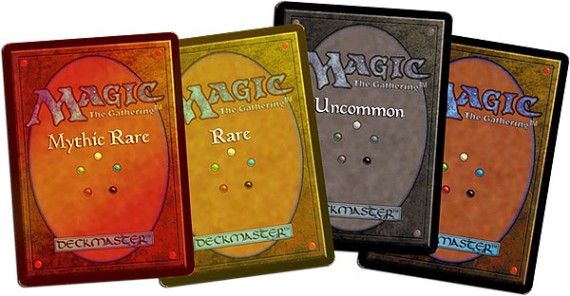|
by Fake Mark Rosewater |
 |
Here at Wizards of the Coast, our work – like the work of Sir Isaac Newton before us – is all about experimentation. Whenever we introduce an exciting new idea, we are testing the waters to see what works and what doesn’t, and what we can rehash further down the line. The ‘free spells’ mechanic in Urza block was a huge success, so we revisited it in New Phyrexia. Increasing planeswalker complexity and utility with Jace, the Mind Sculptor didn’t cause any problems, so we decided to push forward with the five-ability Garruk Relentless, who requires a degree to operate correctly.
With Innistrad we attempted the largest experiment of all, the Magic R&D equivalent of the Large Hadron Collider: double-faced cards. Although St. Richard Garfield originally intended to use card-backs as a means to differentiate between expansions, for the past eighteen years the reverse of a Magic card has been considered sacred ground. Imagine if we could unlock the full powers of both sides of a Magic card – that’s 100% more design space then we’re currently using. In this economic climate, that’s exactly the kind of efficiency-increasing solution we need to be coming up with.
Double-faced cards, of course, have been hugely successful. Meeting with a glowing community reception since they were first spoiled, DFCs have consistently smashed any misgivings that might have been initially held with regards to issues like shuffling and drafting. The fact of the matter is, the idea of a CCG that uses a standardized card-back to conceal information is antiquated. I have previously stated that Innistrad is the beginning of a seven-year plan; by the end of these seven years I hope for every card in Magic to have a completely unique card-back.
We understand that this will be a lot to take in, so rather than leap right in with flip-morph-transform cards that have a card from an entirely different CCG on the reverse, we will be introducing staggered changes to the card-back over the next few sets. Dark Ascension brings us the first and most obvious addition: Color-coding. Starting next February, all card-backs will be subtly recolored to indicate rarity.
I could talk for pages and pages about how great an idea this is, but it might be more interesting for you if I answered a few of your questions instead! Here, then, is the official preliminary card-back FAQ!
What about opaque sleeves?
To properly accommodate the new card-backs, we will regrettably be forced to disallow the use of opaque sleeves from all Magic tournaments. If you really don’t want to go Au-natural, we are pleased to announce that our friends at UltraPro will be selling ‘booster packs’ containing eleven common-backed sleeves, three uncommon-backed sleeves, and one rare-backed sleeve. A small proportion of these packs will even contain a mythic rare sleeve!
While I’m sure that UltraPro’s new product will be of the highest quality, I can’t afford to collect all these sleeves. Must I risk damage to my precious collection?
We’ve got you covered – we will be giving players the option to swap their library with sixty checklist cards.
Doesn’t this mean that all card rarities will be public information?
It absolutely does – we feel that knowing when your opponent is about to draw their mythic bombs will add a strategic dimension to the game, not take anything away from it.
Aren’t you worried about the possibility of cheating used marked card-backs?
Nope!
Tune in next time for the reveal of the next stage in the evolution of the cardback!
